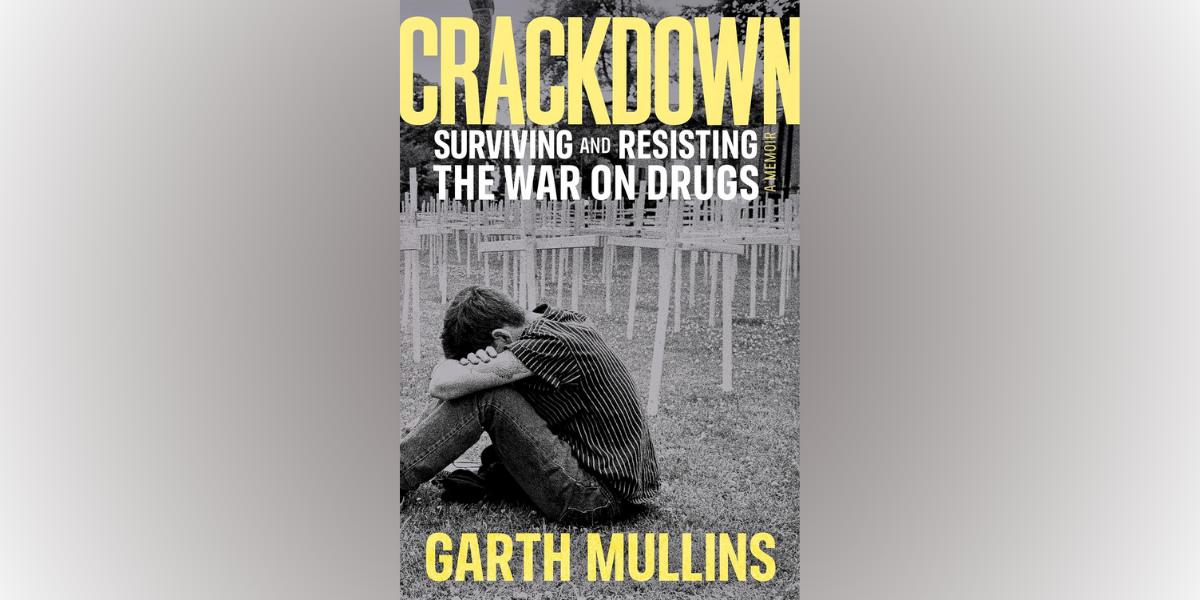Crackdown: Surviving and Resisting the War on Drugs by Garth Mullins (Doubleday Canada, 2025)
In a political moment when right-wing forces mobilize to dismantle even the most modest harm reduction measures, Garth Mullins’ memoir-manifesto arrives as an essential weapon of resistance, exposing the brutal violence of prohibition while charting a path toward collective liberation through user-led organizing.
Crackdown: Surviving and Resisting the War on Drugs emerges as perhaps the most important book on drug policy published in Canada this decade. As Conservative leader Pierre Poilievre weaponizes the overdose crisis for political gain, and governments across the country roll back life-saving harm reduction services, Mullins delivers what those who oppose real harm reduction practices fear most: a powerful, unapologetic account from the frontlines of drug user resistance that fundamentally challenges us to reimagine our relationship to substances and to each other.
This is not merely another addiction memoir of individual redemption or sanitized recovery narratives. Instead, Mullins offers a manifesto rooted in lived experience, speaking to the violence of prohibition, centring the leadership of drug users, and demanding a revolutionary reimagining of our approach to drugs, harm, and solidarity.
Mullins presents a revolutionary perspective that connects personal experience with systemic analysis, refusing the tired tropes of addiction memoirs to focus instead on the collective resistance of drug users and the systemic violence of prohibition. As he writes: “This is no tale of addiction and decay… And it’s not a recovery story.”
It is a manifesto for liberation.
A voice of revolutionary resistance
Mullins brings unparalleled credentials to this narrative. Born with albinism and vision impairment in Yellowknife, Northwest Territories, he grew up confronting ableism, bullying, and a profound sense of exclusion. “I felt like a ghost in my own life,” he recalls. This feeling would later fuel his fierce solidarity with all those pushed to the margins by capitalist society.
Experiencing marginalization from an early age, he found community first in punk rock and later in drug user activism. A former injection heroin user who now relies on methadone, Mullins has lived through multiple overdose crises in Vancouver while becoming a sophisticated advocate for systemic change.
Denied entry to multiple universities at first, Mullins fought for his place at the University of Victoria. There, he discovered both his intellectual capabilities and the transformative potential of organizing. Hosting a radical radio show on a campus-community radio station that blended punk music with leftist politics, he began honing the skills that would later make him a leading voice in drug user activism.
It was also during these years that Mullins first used heroin, not as an act of self-destruction, but as a rational response to pain and exclusion. His description of first using heroin in San Francisco reveals this complexity: “For me heroin wasn’t self-destruction, it was salvation.”
Beyond his lived experience, Mullins is deeply embedded in grassroots organizing, and has been an integral part of Vancouver’s activist community for more than three decades.
In a recent interview about his book, Mullins says, “I spent my life in the labour movement and community organizing against fascism, police brutality, global capitalism, colonialism and climate apocalypse. It was only much more recently that I found the courage to get involved with harm reduction activism.” In recent years, Mullins also served as the President of the Canadian Association of Professional Employees (CAPE) Local 301 and a delegate to the Vancouver & District Labour Council (VDLC).
With this experience, Mullins says that he learned that “the same tactics work for everybody: civil disobedience, mass action, solidarity, coalition building, the way we developed campaigns. I was able to bring my skills from other movements, from the picket lines of strikes, from mass mobilisations against global capitalism, to help the drug user movement.”
In more recent years, he has served as a board member of the Vancouver Area Network of Drug Users (VANDU) and the BC Association of People on Opiate Maintenance (BCAPOM), and was outspoken in the fight against the disastrous 2014 switch to Methadose that destabilized thousands of methadone patients. His involvement and activism within VANDU helped transform the organization into a revolutionary space where drug users organize themselves, fighting for harm reduction, against police violence, and for the right to live with dignity.
Mullins’ activism is rooted in the understanding that the war on drugs is a war on the poor, on racialized people, on disabled people, and on anyone who refuses to conform to capitalist norms.
This wealth of experience and deep political analysis informs every page of the Crackdown book, creating a narrative that is simultaneously deeply personal and broadly political. Mullins’ transformation, from someone primarily focused on personal survival to a sophisticated and outspoken advocate for systemic change, mirrors the broader evolution of harm reduction from individual intervention to collective resistance.
Revolutionary journalism in action
Mullins’ activism is inseparable from his journalism. In early 2019, he launched the Crackdown podcast, a groundbreaking project that puts drug users in the role of “war correspondents” reporting from the frontlines of the overdose crisis.
Rejecting the “objective” stance of mainstream media, the Crackdown podcast is unapologetically partisan, with an editorial board made up of drug user activists. The podcast doesn’t just report on harm reduction; it practices it, training people in overdose response and distributing naloxone. The show’s unique sound, leaving in human moments and featuring feedback-drenched guitar scoring, creates an authentic alternative to sanitized mainstream media coverage.
The Crackdown podcast has won numerous awards, including the Hillman Prize for Journalism, the Third Coast Festival Award for impact, and a New York Festivals award. More importantly, the podcast has trained hundreds of people in overdose response, creating a community of practice that extends far beyond media consumption.
Prior to launching the Crackdown podcast, Mullins was a regular contributor to the well-known and long-running national CBC radio documentary program “IDEAS”, contributing episodes including “The Imaginary Albino” (2013), “End of the Dial: The Future of Radio in a Digital Age” (2014), “The Coming Zombie Apocalypse” (2015), and “Distant Future Warnings: The Challenges of Communicating with Eternity” (2017), each of which were co-produced with his longtime partner, award-winning journalist and radio documentary producer Lisa Hale.
From personal pain to political awakening
Crackdown opens with a funeral—that of Mullins’ friend Nick, who died of an overdose. The scene establishes a central theme: the silence and shame surrounding overdose deaths that prevents honest conversation about drug policy. This opening immediately positions the book not as a story of individual triumph over adversity, but as a collective reckoning with the violence of prohibition.
From this haunting beginning, Mullins takes readers through his childhood experiences of ableism, medical discrimination, and social exclusion in Yellowknife, providing crucial context for understanding how systemic factors create the conditions in which drug use becomes a rational response to unbearable circumstances.
This perspective fundamentally challenges dominant narratives that pathologize drug users while ignoring the structural violence that makes drugs a lifeline for so many and the structural conditions that produce harm. As Mullins demonstrates throughout the memoir, the “war on drugs” functions as an extension of other forms of state violence against marginalized communities, targeting poor and working-class communities while protecting the interests of the wealthy.
The racist roots of prohibition
What elevates Crackdown beyond typical addiction memoirs is Mullins’ sharp political analysis of the drug war. He traces the racist origins of drug prohibition in Canada to the 1908 Opium Act, which emerged from anti-Asian sentiment following the 1907 riots in Vancouver’s Chinatown. “It took less than a year to go from racist riot to racist law,” he writes, framing contemporary drug policy as fundamentally about racial and class control.
Mullins systematically dismantles the myths that sustain prohibitionist drug policy, showing how criminalization increases harm at every level. Mullins’ experiences demonstrate how the threat of arrest prevents people from seeking help, accessing clean supplies, or using drugs in safer environments, directly contributing to preventable deaths.
Mullins’ account of the racial disparities he witnessed in California prisons, with crack cocaine carrying sentences “a hundred times harsher” than powder cocaine, exposes how drug laws are designed to criminalize poverty and Blackness rather than address public health concerns.
The Methadose disaster and organizing for justice
One of the book’s most powerful sections details the catastrophic impact of the 2014 switch from compounded methadone to the pre-mixed Methadose formulation in British Columbia. This policy disaster, made without consultation, destabilized thousands of patients and contributed to the current overdose crisis, and illustrates how even seemingly minor bureaucratic decisions can have devastating consequences for drug users.
Through his work with the BC Association of People on Opiate Maintenance (BCAPOM), Mullins exposed the relationship between the BC government and Mallinckrodt Pharmaceuticals, and how it prioritized corporate profit over patient safety, eventually producing the award-winning two-part Crackdown podcast episode “Change Intolerance” (Part One and Part Two) that revealed the government had granted Mallinckrodt exclusive market access to methadone patients in BC.
This is not just a story of bureaucratic failure, but of structural violence—one that continues as governments roll back harm reduction under the guise of “compassion”.
The story of BC’s Methadose switch serves bureaucratic failure, but of structural violence—one that continues as governments roll back harm reduction under the guise of “compassion”, even within supposedly “compassionate” treatment programs. As Mullins documents, the government’s secret arrangement with Mallinckrodt created a captive market with no alternatives, forcing patients to accept an inferior product that left many inadequately medicated and “dope-sick.”
User-led organizing and collective resistance
Throughout the memoir, Mullins skillfully weaves together his personal journey with broader political analysis. His emphasis on user-led organizing challenges both the punitive approach of the right and the tepid reformism of liberal politicians. He documents how organizations like VANDU, BCAPOM, and the Drug User Liberation Front (DULF) have developed innovative, user-led responses to crisis, from unsanctioned supervised consumption sites to compassion clubs distributing tested drugs. These initiatives prove that drug users are not passive victims but agents of change, possessing unique expertise about what works. Research has shown that DULF’s approach significantly reduced non-fatal overdoses among participants who had access to tested drugs.
The book’s description of the Drug User Liberation Front (DULF) compassion club provides a concrete example of revolutionary practice in action. By distributing tested drugs as a form of direct action against the toxic supply, DULF showed what governments could have been doing all along to prevent overdose deaths.
As Mullins writes: “We knew that we wouldn’t be able to stop the mass dying ourselves… But our compassion club showed what the federal and provincial governments could have been doing all along.”
This emphasis on user-led solutions aligns with socialist principles of self-determination and democratic control. The compassion club model represents mutual aid in practice; communities organizing to meet their own needs when the state fails to provide necessary services. These initiatives demonstrate that drug users are not passive victims but agents of change who possess unique expertise about what works.
Revolutionary optimism and collective healing
Amid its political analysis, Crackdown remains a deeply human story. Mullins describes his journey toward healing through therapy, where he confronted childhood trauma that had haunted him for decades. He writes movingly about his relationship with his wife, Lisa, who supported him through multiple relapses and personal losses.
These personal elements are not separate from the political narrative but integral to it. Mullins shows how healing from trauma and addiction requires not just individual work but supportive communities and structural change. This holistic understanding challenges both the individualistic focus of traditional recovery models and the sometimes-mechanistic approaches of the left.
Particularly powerful is Mullins’ description of a blanketing ceremony held by the Western Aboriginal Harm Reduction Society to honour those lost to overdose. This ceremony represents an alternative to the shame-filled funerals that begin the book, offering a model of collective grief and healing that demonstrates how Indigenous approaches to ceremony and community care provide alternatives to the punitive paradigms of settler colonialism.
Evidence-based resistance and strategic vision
Throughout Crackdown, Mullins grounds his arguments in both lived experience and scientific evidence. This approach reflects his collaborative work with researchers like Ryan McNeil at the BC Centre on Substance Use, who have documented the impacts of various interventions on overdose rates. Recent research continues to support Mullins’ position, with studies showing that neighborhoods with supervised consumption services see significant reductions in overdose mortality rates.
Yet as Mullins notes, evidence alone is insufficient to drive policy change. Political will is required, and this is where grassroots organizing becomes essential. By documenting the successes of user-led initiatives like DULF’s compassion club, Crackdown makes a compelling case for scaling up these approaches.
The book’s vision for drug policy reform is grounded not in abstract principles but in lived experience of what works and what doesn’t. Mullins advocates for a comprehensive approach that includes regulated safe supply, decriminalization, and user-led services, a vision that challenges both the punitive approach of the right and the tepid reformism of liberal politicians.
Building movements for liberation
Mullins’ politics are uncompromising in their anti-capitalist analysis. He understands that the war on drugs is inseparable from capitalism, colonialism, and all forms of oppression. The solutions – safe supply, decriminalization, real harm reduction – already exist. What’s missing is political will, blocked by the interests of the rich and powerful.
Crucially, Mullins centers the leadership of drug users themselves in this transformation. Mullins quotes VANDU board member Hugh Lampkin: “VANDU is a place of redemption. No matter who you were before, this is where you become who you were supposed to be. As we make the world new, we make ourselves new too.” This emphasis on self-determination and democratic control aligns with socialist principles and offers a concrete model for how marginalized communities can organize for liberation.
The book’s treatment of concepts like “crack babies” and drug-related violence reveals how moral panic, rather than scientific evidence, has driven policy decisions. Mullins notes how studies were actually “picking up on the effects of poor nutrition, lack of prenatal care and premature birth that came along with poverty and racism” rather than the direct effects of drug use itself.
Crackdown is at its strongest when it refuses the false choices that dominate drug policy debates. Rather than choosing between “tough on crime” and “soft on drugs,” Mullins advocates for policies grounded in evidence, compassion, and respect for the autonomy and expertise of drug users themselves. His vision is one of regulated safe supply, decriminalization, and user-led services; a vision that challenges both the punitive approach of the right and the tepid reformism of liberal politicians.
Call for revolutionary action
Crackdown concludes with a clear-eyed assessment of the challenges ahead. Mullins acknowledges the strength of the forces arrayed against drug user liberation, from right-wing politicians to the pharmaceutical industry.
Yet Mullins remains committed to the struggle. He writes,“A series of faces flashed in my mind. Nick, Wade, Chereece, Tracey, Flora, Janis, Greg, Dave… And I hoped that they were resting easy, safe in the knowledge that we are carrying on their work. And eventually we will win”.
This commitment to continuing the fight despite setbacks embodies the socialist principle of solidarity in struggle. It reminds us that even when victory seems distant, the work of organizing and building power continues. The book stands as a testament to the resilience of marginalized communities and the power of resistance in the face of systemic oppression.
For socialists committed to harm reduction and anti-capitalist struggle, Crackdown provides both inspiration and a practical roadmap. It challenges us to center the leadership of drug users, to build broad coalitions against prohibition, and to envision a world beyond the drug war. In a political moment dominated by right-wing reaction, this vision of liberation through organized resistance is more necessary than ever.
Crackdown is essential reading for anyone seeking to understand how we got to this crisis and how we might move beyond it through revolutionary transformation. It offers not just a critique of the status quo, but a vision of liberation rooted in the self-activity of the oppressed rather than the machinations of elite reformers. In doing so, it makes an invaluable contribution to the growing movement for drug user liberation and socialist transformation.
Did you like this article? Help us produce more like it by donating $1, $2, or $5. Donate


